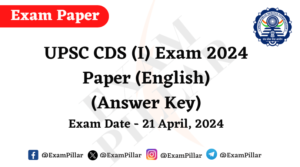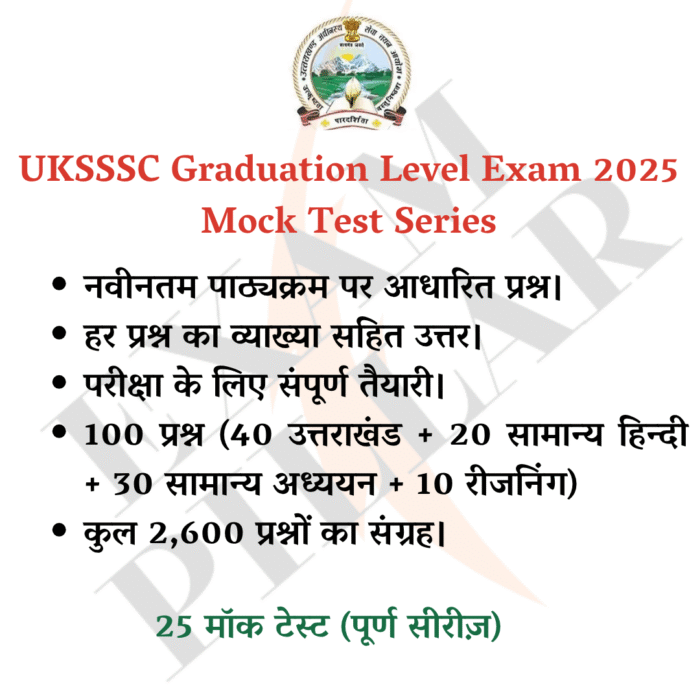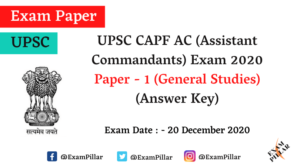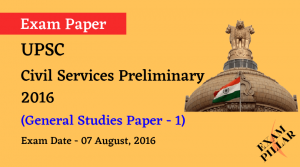UPSC (Union Public Service Commission) Conduct the UPSC (IAS/IFS) Preliminary Exam 2024. This Paper held on 16 June 2024. UPSC General Studies (Paper – I) Full Paper With Answer Key available Here .
| Exam | UPSC Civil Services (Preliminary) Examination 2024 |
| Subject | Paper – I – General Studies (GS) |
| Date of Exam |
16 June, 2024 |
| Total Questions | 100 |
| Paper Set | A |
UPSC IAS (CSE) Pre Exam 2024 (Answer Key)
Paper – I (General Studies)
1. Consider the following statements:
Statement – I : The atmosphere is heated more by incoming solar radiation than by terrestrial radiation.
Statement – II : Carbon dioxide and other greenhouse gases in the atmosphere are good absorbers of long wave
radiation.
Which one of the following is correct in respect of the above statements?
(a) Both Statement-I and Statement-II are correct and Statement-II explains Statement-I
(b) Both Statement-I and Statement-II are correct, but Statement-II does not explain Statement-I
(c) Statement-I is correct, but Statement-II is incorrect
(d) Statement-I is incorrect, but Statement-II is correct
Explanation –Show Answer/Hide
2. Consider the following statements:
Statement – I : Thickness of the troposphere at the equator is much greater as compared to poles.
Statement – II : At the equator, heat is transported to great heights by strong convectional currents.
Which one of the following is correct in respect of the above statements?
(a) Both Statement-I and Statement-II are correct and Statement-II explains Statement-I
(b) Both Statement-I and Statement-II are correct, but Statement-II does not explain Statement-I
(c) Statement-I is correct, but Statement-II is incorrect
(a) Statement-I is incorrect, but Statement-II is correct
Explanation – Show Answer/Hide
3. Consider the following:
1. Pyroclastic debris
2. Ash and dust
3. Nitrogen compounds
4. Sulphur compounds
How many of the above are products of volcanic eruptions?
(a) Only one
(b) Only two
(c) Only three
(d) All four
Explanation – Show Answer/Hide
4. Which of the following is/are correct inference/inferences from isothermal maps in the month of January?
1. The isotherms deviate to the north over the ocean and to the south over the continent.
2. The presence of cold ocean currents, Gulf Stream and North Atlantic Drift make the North Atlantic Ocean colder and the isotherms bend towards the north.
Select the answer using the code given below:
(a) 1 only
(b) 2 only
(c) Both 1 and 2
(d) Neither 1 nor 2
Explanation –Show Answer/Hide
5. Which of the following countries are well known as the two largest cocoa producers in the world?
(a) Algeria and Morocco
(b) Botswana and Namibia
(c) Cote d’Ivoire and Ghana
(d) Madagascar and Mozambique
Explanation – Show Answer/Hide
6. With reference to the Himalayan rivers joining the Ganga downstream of Prayagraj from West to East, which one of the following sequences is correct?
(a) Ghaghara – Gomati – Gandak – Kosi
(b) Gomati – Ghaghara – Gandak – Kosi
(c) Ghaghara – Gomati – Kosi – Gandak
(d) Gomati – Ghaghara – Kosi – Gandak
Explanation – A large number of tributaries like Alaknanda, Ramganga, Kali, Yamuna, Gomti, Ghagra, Gandak, Kosi and Sone, draining 11 states of the country join River Ganga at different confluence points during its journey.Show Answer/Hide
7. Consider the following statements:
Statement – I – Rainfall is one of the reasons for weathering of rocks.
Statement – II – Rain water contains carbon dioxide in solution.
Statement – III – Rain water contains atmospheric oxygen.
Which one of the following is correct in respect of the above statements?
(a) Both Statement-II and Statement-III are correct and both of them explain Statement-I
(b) Both Statement-II and Statement-III are correct, but only one of them explains Statement-I
(c) Only one of the Statements II and III is correct and that explains Statement-I
(d) Neither Statement-II nor Statement-III is correct
Explanation – Show Answer/Hide
8. Consider the following countries:
1. Finland
2. Germany
3. Norway
4. Russia
How many of the above countries have a border with the North Sea?
(a) Only one
(b) Only two
(c) Only three
(d) All four
Explanation – The sea is bordered by the island of Great Britain to the southwest and west, the Orkney and Shetland islands to the northwest,Norway to the northeast, Denmark to the east,Germanyand the Netherlands to the southeast, and Belgium and France to the south.Show Answer/Hide
9. Consider the following information:
| Waterfall | Region | River | |
| 1. | Dhuandhar | Malwa | Narmada |
| 2. | Hundru | Chota Nagpur | Subarnarekha |
| 3. | Gersoppa | Western Ghats | Netravati |
In how many of the above rows is the given information correctly matched?
(a) Only one
(b) Only two
(c) Only three
(d) None
Explanation – Show Answer/Hide
Waterfall
Region
River
Pair 1 is incorrect:
Dhuandhar
Kaimur
Narmada
Pair 2 is correct:
Hundru
Chota Nagpur
Subarnarekha
Pair 3 is Incorrect:
Gersoppa
Western Ghats
Sharavati
10. Consider the following information:
| Region | Name of the mountain range | Type of mountain | |
| 1. | Central Asia | Vosges | Fold mountain |
| 2. | Europe | Alps | Block mountain |
| 3. | North America | Appalachians | Fold mountain |
| 4. | South America | Andes | Fold mountain |
In how many of the above rows is the given information correctly matched?
(a) Only one
(b) Only two
(c) Only three
(d) All four
Explanation – Show Answer/Hide
Region
Name of the Mountain Range
Type of Mountain
Pair 1 is incorrect:
France
Vosges
Block Mountain
Pair 2 is incorrect:
Europe
Alps
Fold Mountain
Pair 3 is correct:
North America
Appalachians
Fold Mountain
Pair 4 is correct:
South America
Andes
Fold Mountain











